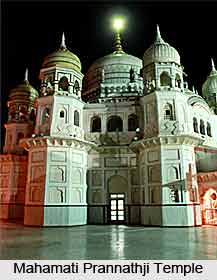 Temples of Panna district are well-known all over the state of Madhya Pradesh and present a fine blend of Hindu and Muslim architecture. The district of Panna is the most sacrosanct pilgrimage for the followers of the Pranami sect world over. The dominant architectural schemes of a majority of the temples are uniformly homogenous. After the decline of the Mughal Empire, Muslim architectural wisdom appeared in these temples like; domes of these temples are plain as well as onion shaped. The temples in the district of Panna have kalasha on top and most of the tallest domes have a lotus form.
Temples of Panna district are well-known all over the state of Madhya Pradesh and present a fine blend of Hindu and Muslim architecture. The district of Panna is the most sacrosanct pilgrimage for the followers of the Pranami sect world over. The dominant architectural schemes of a majority of the temples are uniformly homogenous. After the decline of the Mughal Empire, Muslim architectural wisdom appeared in these temples like; domes of these temples are plain as well as onion shaped. The temples in the district of Panna have kalasha on top and most of the tallest domes have a lotus form.
One of the most famous temples in the Panna district is the Mahamati Prannathji temple. This is the most prominent temples of pranamies which reflects their religious and social life. The construction of the temple was completed in A.D. 1692. It is believed that Prannathji lived here and will remain here and thus became the highest Pranami tirtha as Mahamati`s Punyasthali, and hence Panna is the `param dham` for Pranamies. This temple reminds one of the great Taj Mahal at Agra. The Rang Mahal has eight pahals and each pahal possesses 201 domes. The spherical central dome is as Muslim architecture and the lotus form on this dome is as per the Hindu tradition. The glistering divine golden kalasha is accompanied by the divine panja which denotes Mahamati`s blessing and signifies the Aksharatita Purna Brahman. The main entrance of central dome is known as Kaman Darwaza, made of silver. On Sharada Purnima every year, thousands of people gather at this temple to celebrate the Mahotsava.
Another temple of importance is the Baldeoji temple. It is constructed in the Paladian style as a scaled down replica of St. Paul`s Cathedral in London under the supervision of Mr. Manly, an Italian expert. The temple structure improves upon the Romanesque and Gothick styles prevalent in Britain in 18th Century. This temple consists of a large hall called maha mandapa with massive pillars and is erected on a raised platform so that one may obtain darshan even from out side the main gate. The attractive image of Shri Baldeoji is made in black shaligrami stone. This temple is the finest building in Panna and represents the zenith of architecture of the Panna district.
Padmavati Devi or Badi Devi temple is also well-known in the district of Panna as an important place of pilgrimage. It is situated on the northwestern corner near Kilkila River and it is believed to be a very old temple. The temple has great historical and religious importance under the belief that goddess Padmavati, who was still alive was the protector of prosperity and happiness of Panna. During Nav-Durgotsava, thousands of devotees gather here. Maharaja Chhatrasal Bundela accepted the Goddess as the Raj Lakshami although their kuldevi is Vindhyavasani.
The Jugal Kishoreji temple is the main Hindu temple in the district of Panna and was erected in the Bundela temple style. The natya mandapa, garbha griha, bhog mandapa and pradkshana path are present in this temple. The attire of the Lord is not Brij but Bundelkhandi. According to the common belief, the idol came to Panna from Vrindavan via Orchha. Apart from these temples there are various other temples of great importance in the district of Panna. Some of these temples include Ram-Janki temple, Swamiji temple, Sarang temple, Baiji temple, Govindji temple, etc. All the above temples are located in the Panna town itself except Sarang temple, which is about 20 kilometers from the town.





















